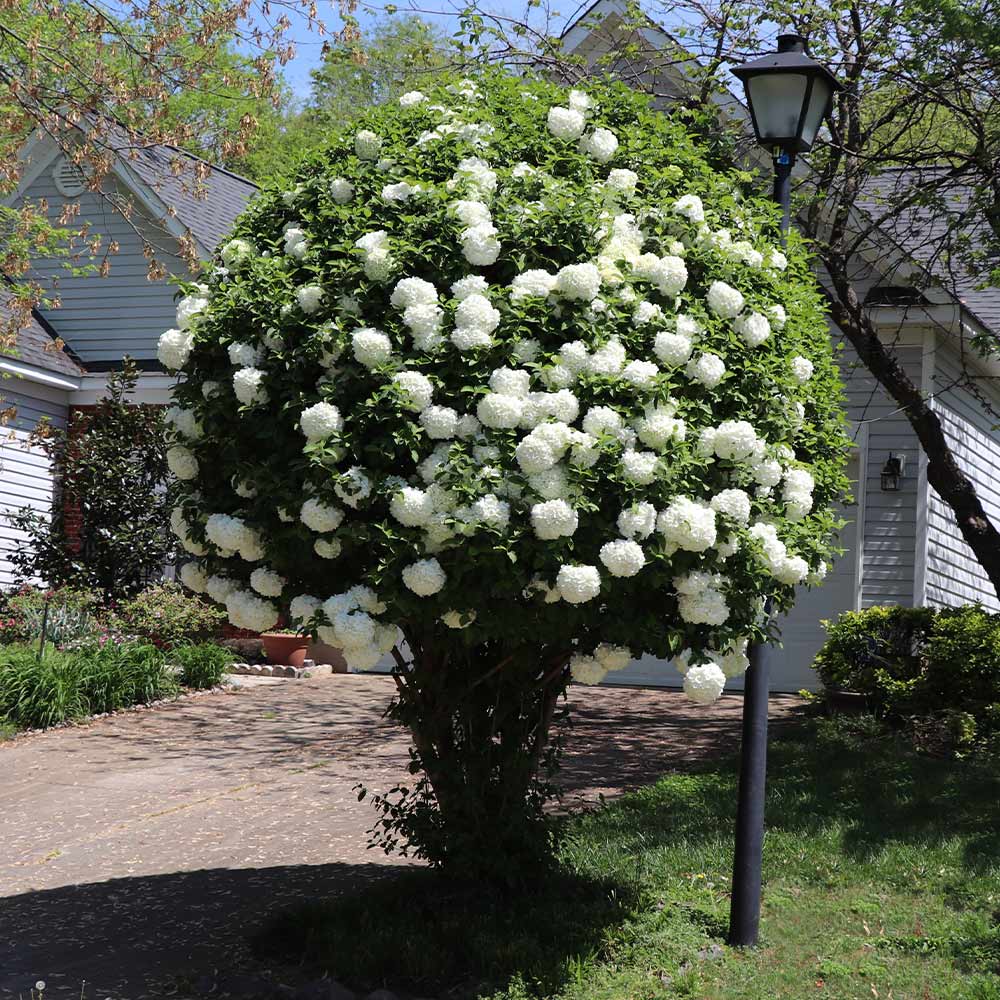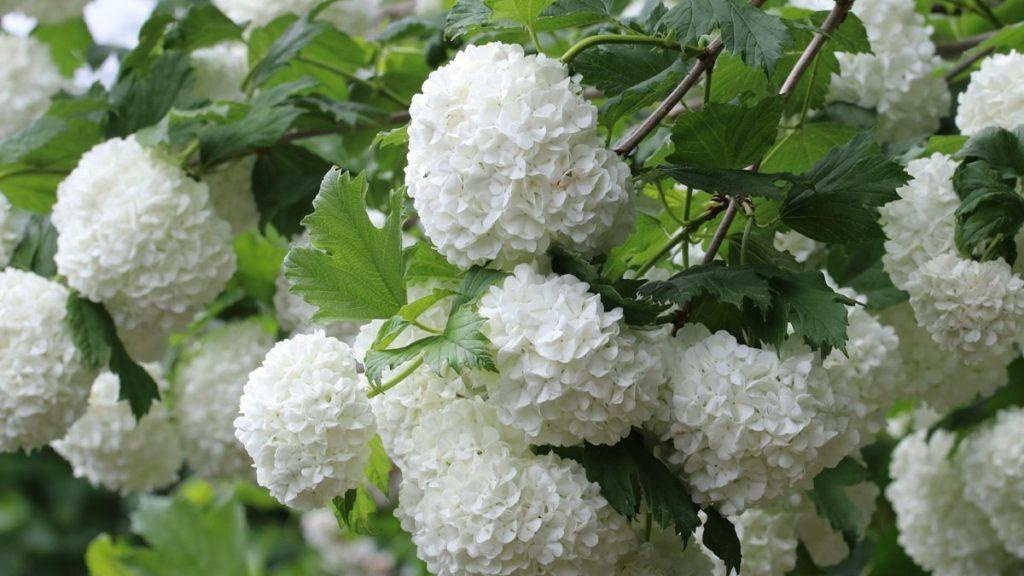Eastern Snowball Viburnum: The Easytogrow Shrub That Will Bloom Your Yard White
Eastern snowball viburnum (Viburnum macrocephalum) is a beautiful and easy-to-grow shrub that is native to eastern North America. It is known for its large, white flowers that bloom in spring, which can measure up to 5 inches in diameter. The flowers are arranged in dense clusters that resemble snowballs, hence the name.
Eastern snowball viburnum is a versatile shrub that can be used in a variety of landscape settings. It can be planted as a standalone specimen, in a shrub border, or as part of a hedgerow. It is also a good choice for pollinator gardens, as it attracts bees, butterflies, and other beneficial insects.
Eastern snowball viburnum is a relatively low-maintenance shrub. It prefers full sun to partial shade and moist, well-drained soil. It is drought-tolerant once established, but it will benefit from regular watering during dry periods. Eastern snowball viburnum is also relatively pest- and disease-resistant.
Main Content
Here are some of the key features of Eastern snowball viburnum:
- Large, white flowers that bloom in spring
- Dense clusters of flowers that resemble snowballs
- Versatile shrub that can be used in a variety of landscape settings
- Attracts pollinators
- Low-maintenance
- Drought-tolerant
- Pest- and disease-resistant
How to Grow Eastern Snowball Viburnum
Eastern snowball viburnum is relatively easy to grow. Here are some tips:
- Choose a planting site that receives full sun to partial shade.
- Amend the soil with compost or other organic matter before planting.
- Plant the shrub at the same depth as it was growing in the nursery pot.
- Water the shrub regularly after planting, especially during the first year.
- Fertilize the shrub in spring with a balanced fertilizer.
- Prune the shrub in late winter or early spring to remove dead or damaged branches.
Eastern Snowball Viburnum Care
Eastern snowball viburnum is a relatively low-maintenance shrub. However, there are a few things you can do to keep it healthy and looking its best:
- Water the shrub regularly, especially during hot, dry weather.
- Fertilize the shrub in spring with a balanced fertilizer.
- Prune the shrub in late winter or early spring to remove dead or damaged branches.
- Protect the shrub from pests and diseases by inspecting it regularly and treating any problems promptly.
Eastern Snowball Viburnum Pests and Diseases
Eastern snowball viburnum is relatively resistant to pests and diseases. However, it can be susceptible to a few problems, including:
- Aphids: Aphids are small, sap-sucking insects that can cause leaves to wilt and curl. They can be controlled with insecticidal soap or neem oil.
- Scale insects: Scale insects are small, oval insects that attach themselves to the bark of plants. They can be controlled with horticultural oil or insecticidal soap.
- Powdery mildew: Powdery mildew is a fungal disease that causes leaves to develop a white, powdery coating. It can be controlled by watering the shrub regularly and avoiding overhead watering.
Conclusion
Eastern snowball viburnum is a beautiful and easy-to-grow shrub that is perfect for adding a touch of elegance to any landscape. It is relatively low-maintenance and resistant to pests and diseases, making it a great choice for even the most novice gardener.
If you're looking for a beautiful and easy-to-care-for shrub, the eastern snowball viburnum is a great choice. These shrubs are known for their large, white snowball-like flowers, which bloom in late spring and early summer. They're also relatively hardy, and can tolerate a wide range of soil conditions and temperatures.
If you're interested in learning more about eastern snowball viburnums, I recommend visiting Garden Wiki. This website has a wealth of information about the plant, including its care requirements, planting tips, and pest and disease prevention information. You can also find photos and videos of eastern snowball viburnums in bloom, so you can see for yourself how beautiful they are.
FAQ of eastern snowball viburnum
- How far apart should Eastern snowball viburnum bushes be planted?
Eastern snowball viburnum bushes can grow up to 20 feet tall and wide, so it's important to plant them far enough apart to give them room to spread. A good rule of thumb is to plant them at least 12 feet apart if you're planting them in a row. If you're planting them in a group, you'll need to allow even more space.
- Can you start an Eastern snowball viburnum from a cutting?
Yes, you can start an Eastern snowball viburnum from a cutting. The best time to take cuttings is in the spring, when the plant is actively growing. Choose a healthy branch that is about 4-6 inches long and has several leaves. Make a clean cut just below a leaf node. Dip the cut end of the cutting in rooting hormone and plant it in a pot filled with moist potting mix. Keep the potting mix moist and place the pot in a warm, sunny location. The cutting should root in about 4-6 weeks.
- What kind of soil does an Eastern snowball viburnum need?
Eastern snowball viburnum prefers well-drained, loamy soil that is slightly acidic. The soil should be moist but not soggy. If you have poor soil, you can improve it by adding compost or peat moss.
- How much sun does an Eastern snowball viburnum need?
Eastern snowball viburnum prefers full sun, but it will tolerate partial shade. If you live in a hot climate, you may want to plant your Eastern snowball viburnum in a location that receives some afternoon shade.
- How do you care for an Eastern snowball viburnum?
Eastern snowball viburnum is a relatively easy plant to care for. Water it regularly, especially during the first year after planting. Fertilize it once a year in the spring with a balanced fertilizer. Prune it in the late winter or early spring to remove dead, diseased, or damaged branches.




Post a Comment for "Eastern Snowball Viburnum: The Easytogrow Shrub That Will Bloom Your Yard White"